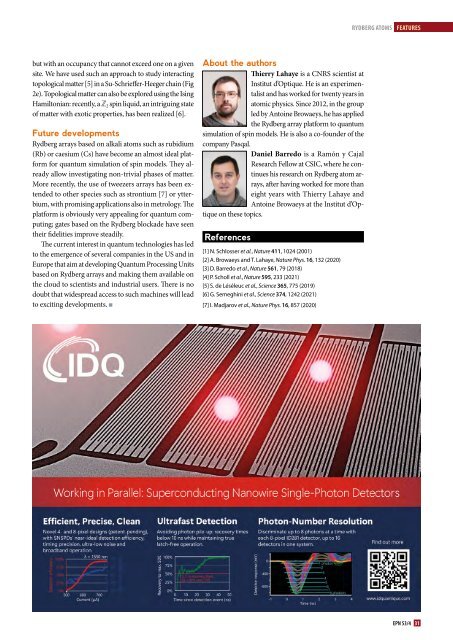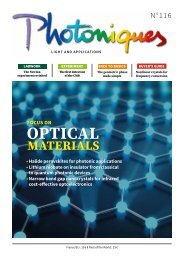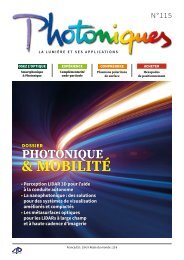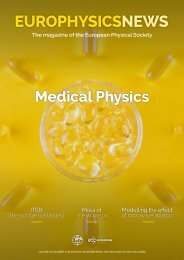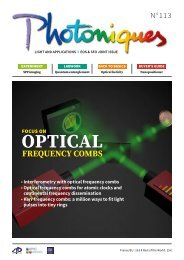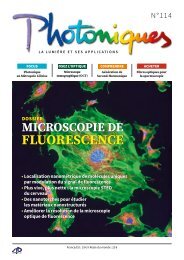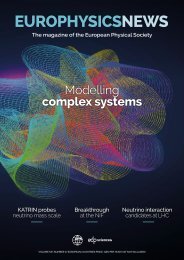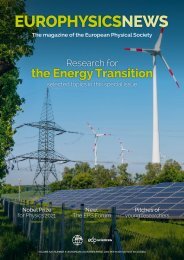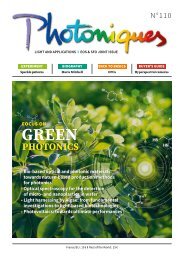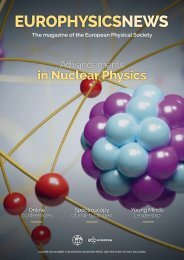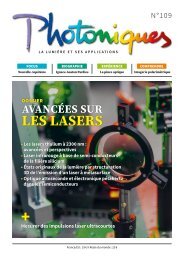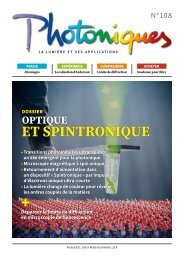Europhysics News 53-4
Europhysics News Quantum Issue
Europhysics News Quantum Issue
You also want an ePaper? Increase the reach of your titles
YUMPU automatically turns print PDFs into web optimized ePapers that Google loves.
Rydberg atoms<br />
FEATURES<br />
but with an occupancy that cannot exceed one on a given<br />
site. We have used such an approach to study interacting<br />
topological matter [5] in a Su-Schrieffer-Heeger chain (Fig<br />
2e). Topological matter can also be explored using the Ising<br />
Hamiltonian: recently, a 2 spin liquid, an intriguing state<br />
of matter with exotic properties, has been realized [6].<br />
Future developments<br />
Rydberg arrays based on alkali atoms such as rubidium<br />
(Rb) or caesium (Cs) have become an almost ideal platform<br />
for quantum simulation of spin models. They already<br />
allow investigating non-trivial phases of matter.<br />
More recently, the use of tweezers arrays has been extended<br />
to other species such as strontium [7] or ytterbium,<br />
with promising applications also in metrology. The<br />
platform is obviously very appealing for quantum computing;<br />
gates based on the Rydberg blockade have seen<br />
their fidelities improve steadily.<br />
The current interest in quantum technologies has led<br />
to the emergence of several companies in the US and in<br />
Europe that aim at developing Quantum Processing Units<br />
based on Rydberg arrays and making them available on<br />
the cloud to scientists and industrial users. There is no<br />
doubt that widespread access to such machines will lead<br />
to exciting developments. n<br />
About the authors<br />
Thierry Lahaye is a CNRS scientist at<br />
Institut d’Optique. He is an experimentalist<br />
and has worked for twenty years in<br />
atomic physics. Since 2012, in the group<br />
led by Antoine Browaeys, he has applied<br />
the Rydberg array platform to quantum<br />
simulation of spin models. He is also a co-founder of the<br />
company Pasqal.<br />
Daniel Barredo is a Ramón y Cajal<br />
Research Fellow at CSIC, where he continues<br />
his research on Rydberg atom arrays,<br />
after having worked for more than<br />
eight years with Thierry Lahaye and<br />
Antoine Browaeys at the Institut d’Optique<br />
on these topics.<br />
References<br />
[1] N. Schlosser et al., Nature 411, 1024 (2001)<br />
[2] A. Browaeys and T. Lahaye, Nature Phys. 16, 132 (2020)<br />
[3] D. Barredo et al., Nature 561, 79 (2018)<br />
[4] P. Scholl et al., Nature 595, 233 (2021)<br />
[5] S. de Léséleuc et al., Science 365, 775 (2019)<br />
[6] G. Semeghini et al., Science 374, 1242 (2021)<br />
[7] I. Madjarov et al., Nature Phys. 16, 857 (2020)<br />
EPN <strong>53</strong>/4 31


